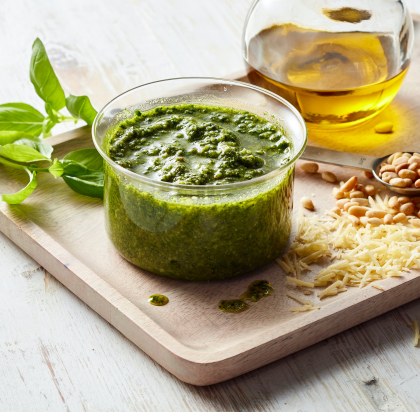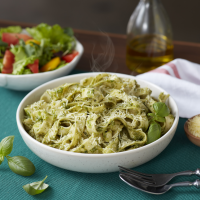How to make pesto
When most people think of pesto, they’re thinking of the traditional “pesto alla Genovese” that originated in the city of Genoa, the capital of Liguria in Italy. It’s made from a blend of fresh basil leaves, raw garlic, pine nuts, parmesan, pecorino, olive oil and salt. But, there are actually hundreds of variations on pesto and you can customise it however you like. If you’ve never made it at home, give this pesto recipe a try! Making it at home is so easy, and it's extra fresh and flavourful.
What does pesto taste like?
Traditional pesto is a thick, green sauce that tastes bright and herby from the basil, and salty and rich from the cheeses and pine nuts. It should be garlicky, with pleasant grassiness from good quality olive oil. The bite from the garlic can be rounded out by heating the sauce, for example with pasta, meats or vegetables.
How do you use pesto?
Pesto can be used as a pasta sauce, sandwich spread, pizza sauce, an accompaniment to meat, fish, chicken and vegetables, in salads, as a dip and much more. Find plenty of recipes that use pesto here.
What else can you put in pesto?
- Instead of basil:
Make different types of pesto without using basil. Try herbs such as parsley or coriander. Soft greens such as rocket, spinach or watercress work well. You can also use vegetables like kale, though they may need to be softened by blanching or wilting. This recipe for coriander pesto uses coriander and cashews, and makes a wonderful accompaniment to a creamy chicken curry. Make a red pesto by using sun-dried tomatoes in place of greens. This variation is tangy and equally delicious. - Instead of pine nuts:
You can make pesto without pricey pine nuts. Walnuts are a favourite substitute due to their similar texture. Almonds, cashews, pecans, macadamias and pistachios are also worth blitzing up. For nut-free pesto, leave out the nuts and add oil gradually to ensure your sauce is not too oily. - Instead of olive oil:
Neutral oils such as peanut, canola or grapeseed work well if you want pesto without olive oil. You won’t have the distinct grassy flavour from the olive oil, so ensure you use a tasty green leaf and cheese and you’ll still have a delicious pesto. - Instead of garlic:
Some say that pesto isn’t pesto without garlic, but you can reduce the amount of garlic to taste or leave it out. You’ll still have a delicious sauce that will work just as well.
Now you know all about pesto and how to customise it, try making it yourself at home! Watch the video below and check out more recipes using pesto.
Traditional pesto recipe
GET THE RECIPE: Perfect Basil Pesto by Perfect Italiano
This basic pesto recipe couldn't be simpler, a handful of ingredients, a quick blitz, and voilà! So much better than the pre-made jars. Trust us, you won't be able to resist putting it on everything.
GET THE RECIPE: Chicken Pesto Pasta by Perfect Italiano
GET THE RECIPE: Cheesy Pizza Puffs Three Ways by Perfect Italiano
GET THE RECIPE: Broccoli Pesto Pasta Salad by Perfect Italiano



























